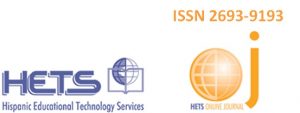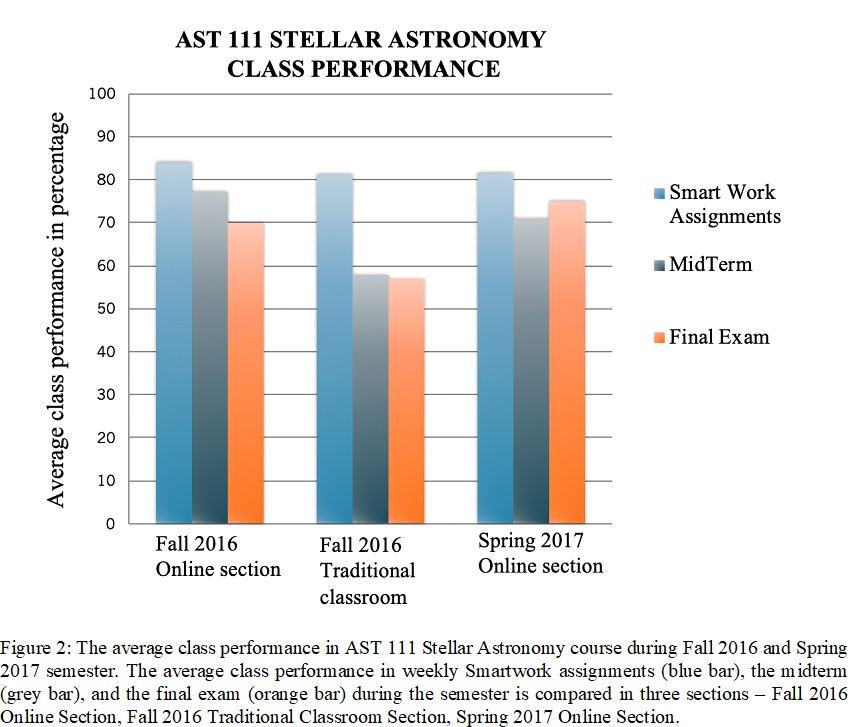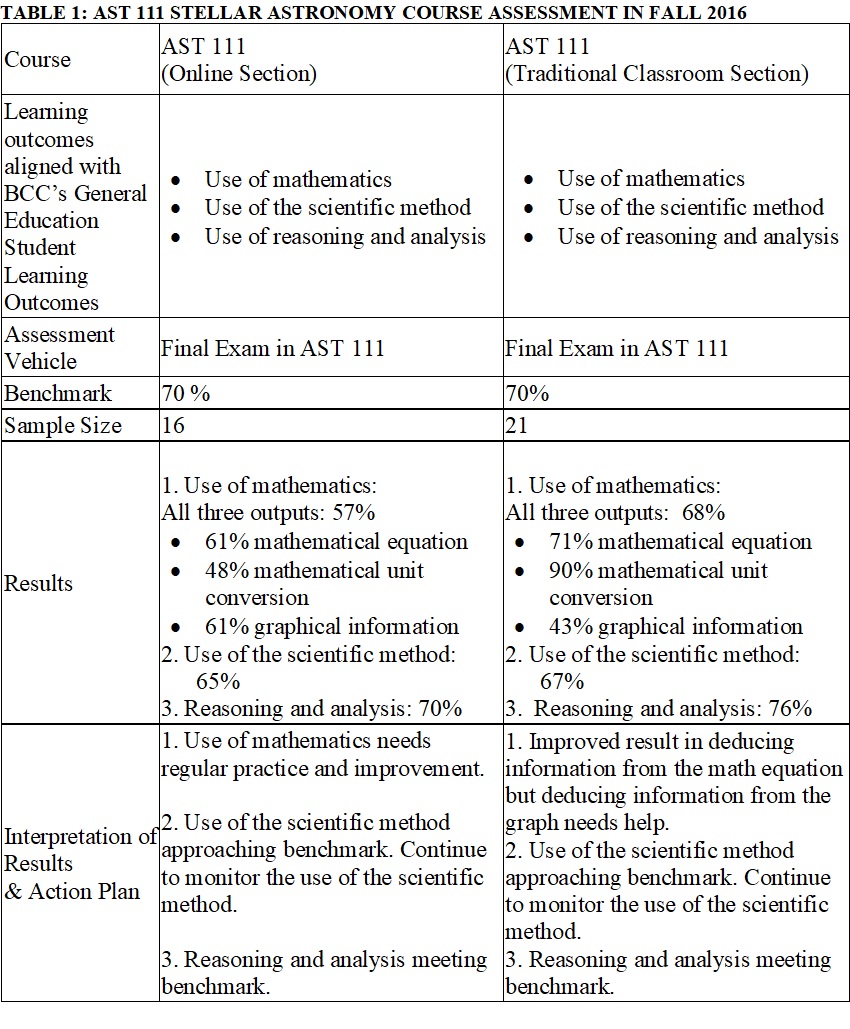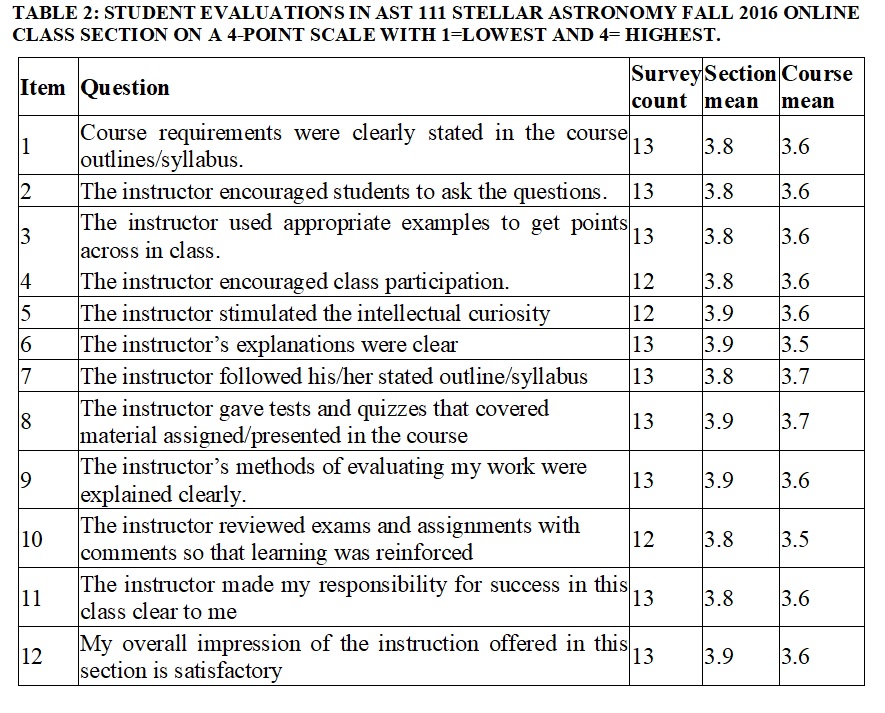Online Learning for Higher Education to Enhance Access, Student Experiences, and Course Outcomes
Department of Engineering, Physics & Technology
2155 University Avenue, Bronx Community College, City University of New York
Bronx, New York 10453-2804
Online Learning for Higher Education to Enhance Access, Student Experiences, and Course Outcomes
Abstract
This paper presents a pedagogical approach and assessment of student performance in a Stellar Astronomy course taught in an online class section and a traditional class section at the Bronx Community College of the City University of New York. The two-year Associate in Arts and Sciences degree program at Bronx Community College offers an astronomy course to fulfill the core science course requirement. The use of an online learning environment in Astronomy for the core science course requirement offers many advantages for students, especially for working students, to enhance their science learning experience. The use of smart technology for a quicker assessment of students’ performances in promptly graded weekly submissions and access to technology-rich Smartwork Astro tours, Astro dictionary, and Nebraska simulations overcomes the various pedagogical challenges of face-to-face classroom settings. Access to online learning allows more students to be reached within a limited time as well as the maintenance of detailed records of student interactions, weekly submissions, and the comprehensive assessment of student performance. Online learning access for a core science course requirement in undergraduate education mitigates barriers to higher education, encourages student-centered learning, and advances teaching in the digital age of the 21st century.
Keywords: online learning, pedagogy, assessment
I. INTRODUCTION
Online education is critical to the long-term strategies of higher education institutions in the United States. By fall 2011, the number of students taking at least one online course increased to 6.7 million – 32% of all college students – including community college students (Allen & Seaman, 2013). Community colleges are pathways to higher education for many minority students who are academically and financially challenged (Mendoza, Mendez, & Malcom, 2009; Rajasekhara & Hirsch, 2000) and for first-generation college students. Many community college students attend college classes, work, and care for dependents while juggling tough financial, academic, and personal challenges (Goldrick-Rab, 2012). The 2011 Community College Institutional Survey (CCIS) reported that 67% of full-time students and 78% of part-time students work at least part-time while taking classes, and 53% of full-time students and 60% of part-time students also care for dependents (CCCSE, 2012). The completion rate of learning online by nontraditional students aged twenty-five and older, overcoming challenges related to work schedules or dependent care at two-year community colleges, was found to be higher than that of traditional student groups aged 17-21 (Newell 2007). Online courses allow students to study course materials on their own time and at their own pace (Bjork, Dunlosky, & Kornell, 2013). Access to online resources has also redefined traditional learning interactions (Anshari, Alas, Yunus, Sabtu, & Hamid, 2016). Online learning can promote self-learning (Rausch & Crawford, 2012), greater student-instructor interaction (York & Richardson, 2012), innovative instructional strategies (Lally & Wallington, 2002), and varied learning styles (Wichadee, 2013), which can lead to better learning outcomes.
The Bronx Community College (BCC) of the City University of New York (CUNY) is a Hispanic-serving Institution located in Congressional District 15, one of the most impoverished districts in the United States. Based on the BCC Spring 2017 survey data from the CUNY Institutional Research Database (IRDB), BCC-CUNY serves a student population comprising 98% ethnic minorities; 55% of students were first-generation college students, 51% were employed, and 25% were supporting children. The Liberal Arts and Sciences curriculum in the Associate in Arts (AA) and Associate in Sciences (AS) degree programs at Bronx Community College require a core science course. Stellar Astronomy (AST 111), offered by the Department of Engineering, Physics and Technology, satisfies the core science course requirement and is offered in a traditional classroom setting as well as an asynchronous (100% online) course offering.
This paper presents the design, content, and innovative instructional strategies used in the online and traditional classroom sections of the Stellar Astronomy course to improve course outcomes. This paper discusses the assessment results of the core competencies – the use of mathematics, the scientific method approach, reasoning, and analysis – in the Stellar Astronomy course using assignments and exams as assessment vehicles in both the online section and the traditional classroom section.
II. MOTIVATION
The author’s primary motivation for teaching an online course was to reach students who were not able to register in the popular Astronomy course due to schedule conflicts, class timings, or other reasons that make it difficult for them to commute to campus during class time. The author received training in online course development conducted by BCC in 2015-16, developed this asynchronous AST 111 Stellar Astronomy course as part of the training, and has been teaching online every semester since.
Best practices in online learning and teaching strategies for educational productivity are well-documented in the pedagogical literature (Pelz, 2004; Kim & Bonk, 2006; The Hanover Research Council, 2009; U.S. Department of Education, Office of Educational Technology, 2012). In his latest book Improving How Universities Teach Science: Lessons from the Science Education Initiative, Carl Weiman, a physicist at Stanford University and 2001 Nobel Prize winner in Physics, discusses the way in which access to information technology provides obvious opportunities for dramatically changing teaching methods in colleges and universities, and in the process, making higher education far more effective and efficient (Weiman, 2017). As the online course was created, the author realized the need to reinvent the traditional classroom section that was not working in all practical senses. Students’ engagement and excitement about learning new materials were limited in the lecture-based methodology that involved the use of a whiteboard, PowerPoint lectures, and standard tests during lectures. Online learning tools were also introduced into the traditional classroom section to supplement lecture-based pedagogy in classroom teaching. Student-centered learning on computers using the digital platform of Smartwork by Norton publishers was implemented during the recitation period, a shorter class to review the lecture material. The Smartwork digital platform provided an opportunity to put students in the driver’s seat and encouraged self-learning by using technology that goes beyond lecture-based learning. The online AST 111 Stellar Astronomy course was created, and at the same time, changes were made in the traditional classroom section of AST 111 to encourage self-learning among students during the recitation time.
Section III describes the methodology applied in the provision of online learning and the pedagogical approach to students’ learning experiences. Section IV describes students’ performance and assessment results in core competencies related to the use of mathematics, the scientific method, and reasoning and an analysis of learning outcomes. Section V provides a discussion of the results, followed by the conclusion in Section VI and future directions in Section VII.
III. METHODOLOGY
Course overview: The AST 111 Stellar Astronomy course covers early astronomy; astronomical coordinate systems; the structure and evolution of the sun, stars, and stellar systems; spectroscopy; the Milky Way and external galaxies; and cosmological models and implications. AST 111 Stellar Astronomy is a 3-credit course scheduled with 2 hours of lectures and a 50-minute recitation period. The AST 111 course requires prerequisites concerning basic math proficiency.
The asynchronous AST 111 Stellar Astronomy course was taught entirely online apart from two in-person class periods. The online course plan, including the lecture content, audio, videos, Nebraska simulations, Astro tours, and Astro dictionary was delivered using the CUNY Blackboard online platform and Smartwork digital system by Norton publishers. The textbook Stars and Galaxies by Norton Publishers (Kay, Palen, & Blumenthal, 2016) was followed in the AST 111 Stellar Astronomy course. The Nebraska simulations used in the astronomy course are the interactive simulations from the University of Nebraska that allow one to manipulate variables and see how physical systems work. The Astro Tours are interactive animations that use art to help students visualize important physical and astronomical concepts. The Astro dictionary provided the meaning of words and concepts used in the field of astronomy.
Learning outcomes: The following learning outcomes expected in this course were clearly explained to the students during the first class:
- Identify principles governing astronomical phenomena, interpret astronomical evidence to characterize applicable physical laws, construct diagrams indicating correlations of the physical properties of stars, and classify and predict star evolutions according to intrinsic properties, such as stellar mass.
- Use algebraic calculations and graphing to predict, measure, and verify that physical principles apply to astronomical phenomena.
First, the in-person class provided an overview of the course plan, learning outcomes, grading policy, lesson plan, and instructions regarding how to navigate on Blackboard and Smartwork to access the syllabus, course materials, and assignments. A demo exercise comprising a homework assignment, web-based writing assignment, and online discussion link was created for submission during the first in-person class to establish the flow of online instruction.
Weekly folder: The weekly folder as per the BCC academic calendar was named according to the lecture date in the respective courses, for example, “Week 1_27 August 2016,” and was provided on Blackboard. The weekly folder comprised two separate folders containing the lecture notes and assignment submissions. The lecture notes included lectures in PowerPoint and word documents, audio, video, Astro tours, flashcards containing astronomy vocabulary, Nebraska simulations, or astronomy news of the day. Figure 1 shows a sample of “Astronomy news of the day,” which introduced students to current exciting news relevant to the subject of astronomy or content in the syllabus. The assignment submissions folder included an electronic link (e-link) to submitting Blackboard web-based writing assignments, online discussions, or Smartwork assignments “Test your Understanding” and “Process of Science” depending upon the lesson plan of the day.
Weekly assignments were provided to both the online section and the traditional classroom section on the CUNY Blackboard and Smartwork online system. However, in the traditional classroom section, the computer lab was used to supplement lecture-based teaching with Smartwork class assignments, Nebraska simulations, Astro tours, and Astro demonstrations in person. The course textbook and supporting resources were the same for the online section and the traditional classroom section. The online section had slightly more Smartwork homework assignments than the traditional classroom section. The Smartwork assignments for the traditional classroom section were split into homework assignments and classwork assignments to be attempted during the recitation period. The tests for the online section were restricted in time using the online time limit settings on Smartwork, whereas traditional classroom sections took tests in class. The weekly Smartwork assignments included multiple-choice questions, numerical questions, match the following, fill in the blanks, true or false, and drag-and-drop items that provided comprehensive practice on quantitative and analytic skills. The Smartwork system provided students with a user-friendly computer experience, promptly graded assignments, and allowed instructors to place more focus and time on the analytics of student performance. Student-instructor and student-student interactions were encouraged with writing assignments and discussions graded by the instructor on Blackboard.
Grading: The grading distributed between the weekly assignments, the midterm exam and the final exam, was included in the syllabus. The traditional classroom section had a slightly different grading policy that included class assignments using Blackboard and Smartwork online system in the grading distribution.
The last class: The last in-person class conducted during the final class of the semester provided a review of the course plan, clear instructions for the final exam, and collected student feedback on the course evaluation.
The two in-person classes, at the beginning and end of the semester, provided an opportunity to connect as a class, between students, and between instructor and students.
IV. RESULTS
The assessment of learning outcomes provided students with feedback to guide their learning. Assessment was also helpful for faculty to guide their teaching and implement successful strategies to improve learning outcomes. One of the learning objectives in astronomy is for students to be able to understand the structure, dimension, and content of the universe. Overall student performance in the AST 111 Stellar Astronomy course in the online and traditional in-class sections was evaluated in three core competencies: use of mathematics, use of the scientific method, and reasoning and analysis. Table 1 highlights the assessment of these core competencies in both the online and traditional classroom sections of the AST 111 Stellar Astronomy course in fall 2016.
The final exam administered to both online and traditional classroom sections was used as an assessment vehicle. The sample size in the online course was smaller than that in the traditional classroom section due to different enrollment caps in these two courses. A benchmark of 70% in all the core competencies was used as a criterion of success, that is, 70% of the students will score 1/1 point in multiple-choice, analytic, or numerical questions related to core competencies or 3.5 points out of 5 points or better in the writing question. The overall student performance in AST 111 during the semester was also assessed using assignments and tests as assessment vehicles.
Figure 2 highlights the class performance of the AST 111 online and traditional classroom sections in Fall 2016 and the online section in Spring 2017. The class performance in Smartwork weekly online assignments was averaged at 84% in the AST 111 online class section and 81% in the AST 111 traditional classroom section in Fall 2016. The midterm for the online section was provided online and restricted in time using Smartwork online settings. The traditional classroom section took the midterm exam in class. The midterm contributed 20% towards the final grade in both sections. The average class performance on the midterm exam in the online section was 19% higher than that of the traditional classroom section in Fall 2016. The average class performance on the final exam in the online section was 13% higher than that of the traditional classroom section. The overall class average performance was distributed between the assignments, midterm, and final exam. The overall class average performance was 7% higher in the online section than in the traditional classroom section in Fall 2016. The maximum number for student enrollment is capped at 20 in online course sections and 24 in traditional Astronomy classroom sections at Bronx Community College. A total of 3 out of 19 enrolled students in the online section and 2 out of 23 enrolled students in the traditional classroom section withdrew from the course during the Fall 2016 semester.
The average class performance in the online section of AST 111 Spring 2017 was also comparable to the Fall 2016 online section in Smartwork assignments, the midterm, and the final exam (figure 2). Of the 20 students enrolled in the AST 111 Spring 2017 online section, two students withdrew and the overall average class performance was 3% less than the Fall 2016 online section, but the average class performance in the online final exam was 5% higher than the Fall 2016 online section.
V. DISCUSSION
The average class performance in Smartwork weekly online assignments was 3% higher in the online section than in the traditional classroom section of AST 111 Fall 2016. The online section was relatively more proactive than the traditional classroom section in submitting weekly homework assignments on time. The automated due dates set up in accessing the weekly homework assignments and penalties for failing to submit work on time could be a contributing factor to timely submissions. The traditional classroom section was keener on submitting in-class assignments completed during the recitation period in the computer lab.
The average class performance on the midterm was 19% higher in the online section than in the traditional classroom section. The higher performance could be the result of the open-book possibility in the online section. The online class was provided with relatively less time to attempt the midterm online to accommodate the possibility of open-book access by students during the exam. The exam, once started, had to be finished in one sitting within two hours in the online section. In comparison, the traditional classroom section took a closed-book midterm exam within 2 hours and 50 minutes. The 13% higher final exam performance of the online section than the traditional classroom section could also be due to the open book possibility during the exam. The final exam assessment in the online section shows that only 61% of students responded correctly to the mathematics equation-based question, and 48% answered correctly to the unit conversion question in the final exam (Table 1). On the other hand, the traditional classroom section was able to perform better in mathematics skills. The traditional classroom section received more in-person attention to practice mathematics skills during lecture time, which could be a contributing factor in this performance. The performance in mathematics skills in the online section did not meet the benchmark of 70% despite regular assignments, including practice in mathematical skills.
The online section performed 18% better in deducing information from graphs. The relatively higher use of digital course materials such as Astro simulations, Astro tours, and other online study aids for conceptual understanding of astronomy could have contributed to this higher performance. The traditional classroom section, on the other hand, relied more on textbook reading and lecture time to develop their conceptual understanding. The use of the scientific method in developing conceptual understanding approached the benchmark in both the online and traditional classroom sections. This area needs to be further monitored to improve the outcomes of the astronomy course. The reasoning and analysis successfully met the 70% benchmark in this course.
Student Evaluations in the Course/Faculty Report
Student ratings of instruction are widely used in universities to measure teaching effectiveness (Dresel & Rindermann, 2011). Table 2 highlights some of the students’ responses in the course/faculty report administered by BCC-CUNY at the end of the Fall 2016 semester. The course/faculty report provides data on a 4-point scale with 1=lowest and 4=highest. Table 3 highlights some of the students’ comments related to enhanced student learning experiences in the course/faculty report of the Fall 2016 online section.
VI. CONCLUSION
Online learning in higher education is an important alternative to traditional classroom learning and provides students with potential savings in costs and time. The availability of an online learning environment for a core science course requirement offers many advantages for students, especially working students, to enhance their science learning experiences. The use of ubiquitous technologies to improve knowledge and skills is imperative in the digital age of the 21st century. The assessment of this astronomy course showed that students performed as well in an online section as they did in a traditional classroom section, and that online pedagogical elements could be integrated into the traditional classroom section. It is important that colleges recognize the potential of online learning for requisite core courses as an integral part of colleges’ functions and mission in providing access to enhance students learning experiences and improve course outcomes.
VII. FUTURE OUTLOOK
Students’ performance in one of the core competencies – mathematical skills – did not meet the benchmark despite regular assignments that included practice in mathematics skills. Innovative strategies must be included in practice to improve students’ performance in mathematics. Norton’s “At Play in the Cosmos” video game for Introductory Astronomy is one such hands-on activity that may be utilized in upcoming semesters. A lesson plan based on quantitative reasoning and involving unit conversion in mathematics could be infused into this course at the beginning of the semester. The assessment of student performance in the lesson plan will help set the pace of numerical efficiency and mathematics skills for the rest of the semester.
REFERENCES
Allen, I. E., & Seaman, J. (2013). Changing course: Ten years of tracking online education in the United States. Sloan Consortium. PO Box 1238, Newburyport, MA 01950.
Anshari M., Alas Y., Yunus N., Sabtu N. I., & Hamid M. H. (2016). Online learning: Trends, issues, and challenges in the Big Data era. Journal of e-Learning and Knowledge Society, 12(1), 121-134.
Bjork, R. A., Dunlosky, J., & Kornell, N. (2013). Self-regulated learning: Beliefs, techniques, and illusions. Annual Review of Psychology, 64, 417-444.
Center for Community College Student Engagement. (2012). A matter of degrees: Promising practices for community college student success (a first look). Austin, TX: The University of Texas at Austin, Community College Leadership Program.
Dresel, M. & Rindermann, H. (2011). Counseling university instructors based on student evaluations of their teaching effectiveness: A multilevel test of its effectiveness under consideration of bias and unfairness variables. Research in Higher Education, 52(7), 717-737.
Goldrick-Rab, S. (2012). Challenges and opportunities for improving community college student success. Review of Educational Research, 80(3), 437-469.
Kay, L., Palen, S., & Blumenthal, G. (2016). 21st century astronomy. WW Norton Publishers.
Kim, K., & Bonk, C. J. (2006). The future of online teaching and learning in higher education: The survey says … A survey substantiates some ideas about online learning and refutes others. Educause Quarterly, 4.
Lally, V. & Wallington, J. (2002). Enticing e-learning. The Times Educational Supplement, 23.
Mendoza, P., Mendez, J. P., & Malcolm, Z. (2009). Financial aid and persistence in community colleges: Assessing the effectiveness of federal and state financial aid programs in Oklahoma. Community College Review, 37(2), 112-135.
Newell, C. C. (2007). Learner characteristics as predictors of online course completion among nontraditional technical college students. (Doctoral dissertation, University of Georgia).
Pelz, B. (2004). (My) three principles of effective online pedagogy. Journal of Asynchronous Learning Networks, 8, (3).
Rajasekhara, K., & Hirsch, T. (2000). Retention and its impact on institutional effectiveness at a large urban community college. Baltimore Community Coll., MD. Presented at 40th Association for Institutional Research (AIR) Annual Forum Cincinnati, Ohio.
Rausch, D. & Crawford, E. K. (2012). Cohorts, communities of inquiry, and course delivery methods: UTC best practices in learning—the hybrid learning community model. The Journal of Continuing Higher Education, 60, 175-180.
The Hanover Research Council. (2009). Best practices in online teaching strategies. Retrieved from https://www.etsu.edu/cas/litlang/composition/documents/best-practices-in-online-teaching-strategies-membership.pdf
U.S. Department of Education, Office of Educational Technology. (2012). Understanding the implications of online learning for educational productivity. Washington, D.C.
Wichadee, S. (2013). Facilitating students’ learning with hybrid instruction: A comparison among four learning styles. Electronic Journal of Research in Educational Psychology, 11(1), 99-116.
Wieman, C. E. (2017). Improving how universities teach science: Lessons from the science education initiative. Harvard University Press.
York, C. S. & Richardson, J. C. (2012). Interpersonal interaction in online learning: Experienced online instructors’ perceptions of influencing factors. Journal of Asynchronous Learning Networks, 16(4), 83-98.
Trackback from your site.








